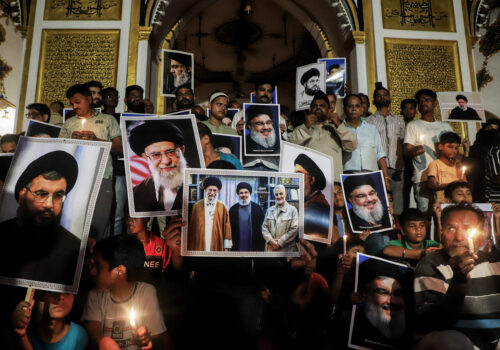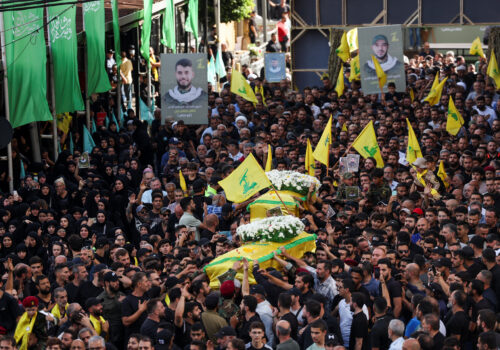Israel has lost its patience
As the first anniversary of the conflict along the Lebanon-Israel border approaches, what has been, for the most part, a simmering daily series of tit-for-tat strikes between Israel and Hezbollah has escalated at an alarming pace and brought the region perilously close to a full-scale war.
Since September 16, Israel has removed the gloves to stage a massive aerial bombing campaign targeting the party’s top political and military leadership and what it says are thousands of Hezbollah weapons sites in a bid to force the Iran-backed group to yield and redeploy its forces away from Lebanon’s southern border, which would allow the return of some 60,000 evacuated Israelis to their homes. On September 27, Hezbollah received its deadliest blow in decades when Israel dropped dozens of bunker buster bombs on the group’s underground headquarters in southern Beirut, killing the party’s veteran leader Hassan Nasrallah and other top security officials. Hezbollah has responded by intensifying its rocket and drone attacks into Israel, concentrating on military targets covering northern and central Israel to the outskirts of Tel Aviv. On October 1, elite Israeli troops inched across the border into Lebanon, launching what Israel says is a “focused operation” against Hezbollah military facilities in Lebanon’s southern border area.
The result is that both sides have inched closer to the threshold, which, if crossed, could lead to a full-scale war between the two enemies—one that could easily become a regional conflagration.
SIGN UP FOR THIS WEEK IN THE MIDEAST NEWSLETTER
To an extent, Hezbollah has fallen into a trap of its own making. It launched its “support front” a day after Hamas staged an unprecedented assault against Israeli communities and military positions around the Gaza Strip on October 7, 2023. Hezbollah’s leaders have repeatedly stated that the organization will continue attacking Israel until the war in Gaza comes to an end. Therefore, it has been understood for months that only a ceasefire agreement in Gaza will lead to an end of the hostilities along the Lebanon-Israel border. The ceasefire remains elusive, however, and Israel’s patience with Hezbollah has run out.
Israel’s new offensive began on September 16 with an unprecedented attack against Hezbollah cadres using booby-trapped pagers, which exploded simultaneously. The next day, walkie-talkies exploded. The two attacks killed at least thirty-two people and wounded some 3,500. On September 20, Israel assassinated Ibrahim Aql, the head of Hezbollah military operations and commander of the Radwan Brigade, Hezbollah’s top combat unit. His death came a month and a half after Israel assassinated top Hezbollah military leader Fouad Shukr, one of several top combat commanders to have been targeted by Irael since the conflict began last October.
One important consideration that has helped keep the fighting below the threshold of all-out war is that Hezbollah has not yet begun using its more advanced weapons systems, namely its arsenal of precision-guided missiles. On September 25, it fired a single Qadir-1 liquid-fueled missile toward the headquarters of Israeli intelligence agency Mossad near Tel Aviv. The missile was intercepted by Israeli aerial defense systems, as Hezbollah no doubt expected. The launching of the missile served as a warning to Israel that Hezbollah has only used unguided legacy rockets to strike Israeli targets. It is believed to possess an arsenal numbering some 150,000 rockets and missiles of varying calibers and ranges, including precision-guided systems that carry five hundred kilogram warheads and can strike within fifty meters of their target. The reason why it has not yet resorted to more sophisticated systems is due to Iran. Tehran does not want Hezbollah, a key component of its deterrence architecture—the Resistance Axis—to become embroiled in a massive and debilitating war with Israel for the sake of Hamas in Gaza. Hezbollah is far too important an asset for Iran to waste in such a manner. If Hezbollah were to begin launching its Fateh-110 missiles, for example, into Tel Aviv and other areas of Israel, it would undoubtedly trigger a full-scale war. Iran’s caution has led to some frustration among Hezbollah cadres who would prefer using the more advanced systems to inflict real damage and pain on Israel.
Despite the intensity of Israel’s aerial campaign and targeted assassinations of Hezbollah commanders, it is against the organization’s DNA to yield to the onslaught and plea for a ceasefire. Indeed, the level of damage that Hezbollah has sustained remains unclear at present. Israeli officials have claimed that half of Hezbollah’s precision-guided rockets have been destroyed in the air strikes and that the organization is in disarray. There is little evidence so far to back such a claim. Hezbollah has escalated its rocket attacks into Israel at an increased daily rate and is hitting Israeli military targets deeper inside Israel than before. It has begun employing larger rocket systems not previously used in the one-year conflict. Its fighters are still attacking targets of opportunity—such as Israeli tanks and troop movements—along the Blue Line, the United Nations name for the Lebanon-Israel border, suggesting that the cadres remained entrenched in south Lebanon despite the aerial onslaught. On October 2, Hezbollah staged several ambushes against elite Israeli troops, killing eight soldiers and wounding several others in what was the first day of ground combat in south Lebanon.
There are parallels here to the 2006 war, which began when Hezbollah kidnapped two Israeli soldiers from across the Blue Line. In 2006, Israel anticipated that it could defeat Hezbollah by air power alone, thus sparing having to deploy troops into south Lebanon. After two weeks of striking Hezbollah targets across south Lebanon, the flow of Hezbollah’s rockets into Israel was unchecked. Israel then decided to send troops across the border in what was an ultimately failed attempt to locate and destroy the rocket launchers. After one month of fighting, a ceasefire was reached, and Hezbollah declared a “divine victory.”
Therefore, under current circumstances, Hezbollah has little choice but to absorb the blows being delivered by Israel and to keep firing rockets, missiles, and drones into Israeli territory, thus thwarting Israel’s war goal of effecting a Hezbollah retreat from the border and the return of evacuees to their homes in the north. Some Israeli officials have spoken of resurrecting the “security zone” that Israel operated between 1978 and 2000 in south Lebanon to ensure that Hezbollah cannot reach the border. By deploying troops, albeit in limited numbers so far, into south Lebanon, Israel risks playing into the hands of Hezbollah which has had eighteen years to prepare the ground for such an eventuality. An Israeli incursion could help level the playing field to an extent to Hezbollah’s advantage as the fighting would shift to its home ground.
Given the elusiveness of a ceasefire in Gaza, the Lebanon-Israel front can be expected to remain a highly volatile theatre, and even if neither side seeks an all-out war, that possibility is inching ever closer.
Nicholas Blanford is a nonresident senior fellow with the Atlantic Council’s Middle East Programs.
Further reading
Tue, Oct 1, 2024
Hezbollah c’est moi: The Party of God without Hassan Nasrallah
MENASource By David Daoud
The person and the position became synonymous.
Thu, Sep 19, 2024
Israel’s communications attacks push Hezbollah into an uncomfortable corner
MENASource By David Daoud and Natalie Ecanow
Hezbollah has no choice but to retaliate—but the group is unlikely to declare a full war given its constraints.
Wed, Sep 11, 2024
As the Israel-Hamas war continues, the Abraham Accords quietly turns four
MENASource By Marcy Grossman
The Abraham Accords have laid a foundation far beyond any one conflict for greater peace in the region.
Image: People inspect damage, in the aftermath of Israeli strikes on the Mreijeh neighbourhood in Beirut’s southern suburbs, amid cross-border hostilities between Hezbollah and Israel, in Beirut, Lebanon October 4, 2024. REUTERS/Ali Alloush




